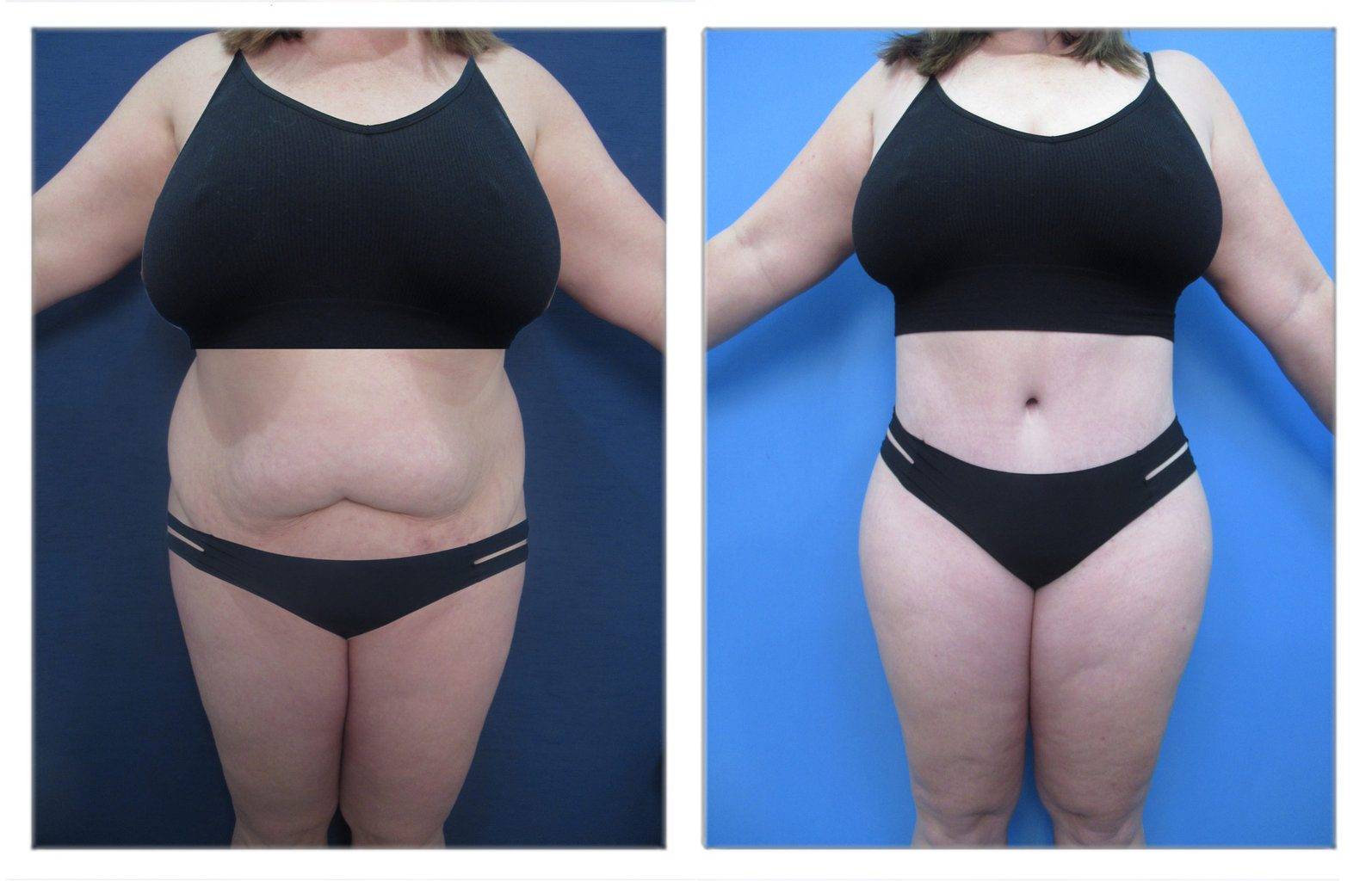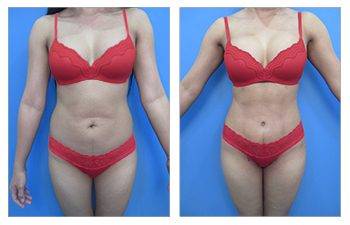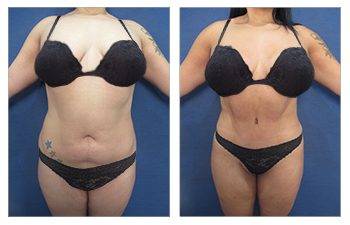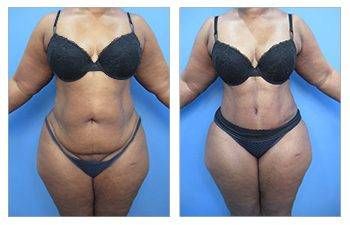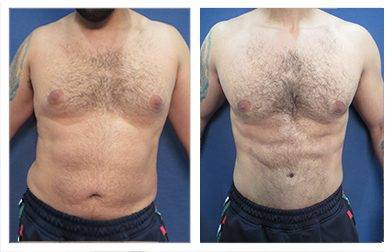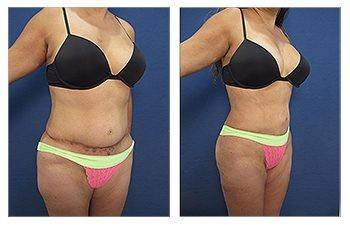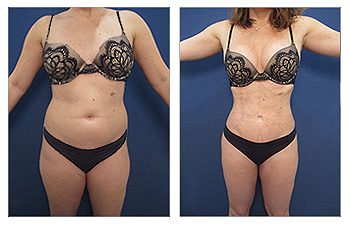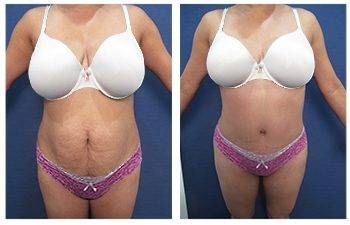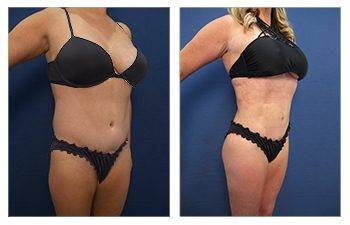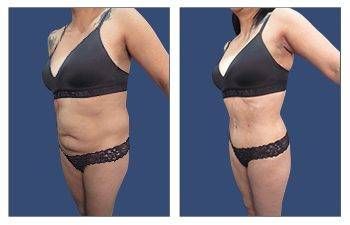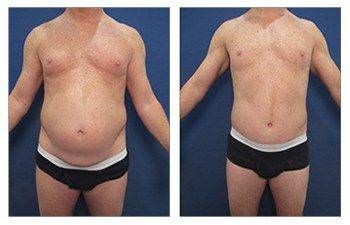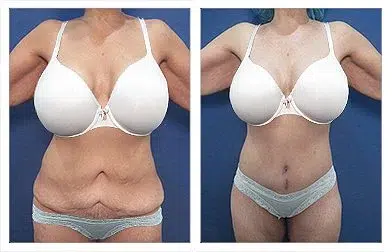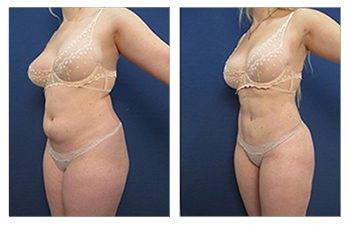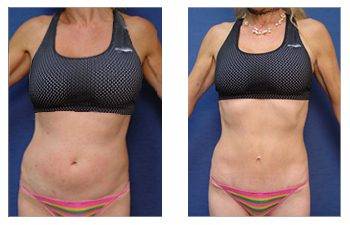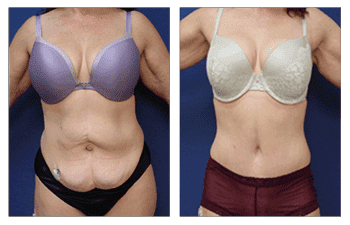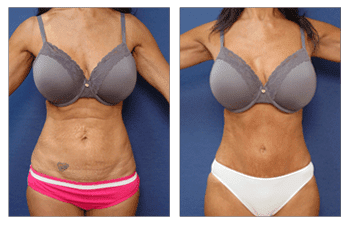Tummy Tuck
Tummy Tuck CASE STUDIES
Introduction to Tummy Tuck
- Redundant abdominal skin, loose skin.
- Protruding abdomen due to stretched-out muscles
- Unattractive skin texture and appearance especially surrounding the belly button (stretch marks)
- Loss of feminine silhouette
The first goal of tummy tuck surgery is to correct the separated (ventral hernias) and weakened (attenuated) abdominal muscles resulting in the appearance of a bloated abdominal in profile. If you look like you are always protruding, you are not alone in desiring a taut and well-defined abdomen.
Most people strive for this result through exercise and weight control. Unfortunately, proper diet and strenuous exercise won't tighten stretched-out abdominal musculature. Strenuous activity will only stretch and tear your abdominal muscles and make you protrude more. Massive weight loss may improve your belly prominence by reducing the gut fat pushing your muscles. However, even following weight loss, will complain of residual belly prominence that can only be corrected with complete abdominoplasty that can be performed as an outpatient procedure. It is important first to expose the abdominal muscles to repair or tighten them. Exposure of the muscles requires an incision followed by undermining the abdominal skin up to the rib cage following the release of the belly button stalk. Only then can the abdominal muscles be repaired.
The second goal of tummy tuck surgery is to remove loose skin and skin that has lost the quality of its texture, referred to as stretch marks. Since the elimination of stretchmarks is limited by how much skin can be removed while being able to repair the abdominal skin flap, patients desiring this major surgery must maintain realistic expectations. A complete abdominoplasty requires the correction of loose or weakened muscles and the elimination of skin redundancy.
If you would like more information on whether a full tummy tuck or a mini tummy tuck is best for you, you can just read this article.
Surgical details are described by the figures below.
Why should you choose SurgiSculpt for your Tummy Tuck surgery? SurgiSculpt is well regarded by the Orange community for its outstanding tummy tuck technique and superior before and after results. Three considerations listed below allow SurgiSculpt to obtain superior tummy tuck before and after outcomes for their Newport Beach abdominoplasty clients that include:
- The incision for a full Tummy Tuck (abdominoplasty) surgery involves a horizontally-oriented incision in the space between your pubic hairline and the belly button. This incision must be made low enough to be hidden in your undergarments.SurgiSculpt determines the shape and length of your incision based on the amount of excess skin that can be safely removed. This determination can be made only once your abdominal skin is lifted, and your underlying weakened abdominal muscles are repaired. This incision is routinely reassessed intraoperatively and lowered depending on the dynamic of your abdominal skin tension to ensure that a “low” incision line is secured to optimize your outcome.Tummy Tuck Orange County Cosmetic Surgeons at SurgiSculpt pull down the upper abdominal skin like a window shade. They then remove the excess skin by trimming it and suturing the remaining skin together. At this point, SurgiSculpt surgeons re-evaluate the incision line position and placement before completing the incision line repair to ensure optimum tummy tuck results.
SurgiSculpt also creates a new opening for your belly button. Your new belly button is pushed through to the skin's surface and then sutured into its new position. Our expert Newport Beach plastic surgeon will ensure an aesthetically appealing belly button without an “operated” look.
Abdominoplasty Surgical Overview
Why should you choose SurgiSculpt for your Tummy Tuck surgery? SurgiSculpt is well regarded by the Orange community for its outstanding tummy tuck technique and superior before and after results. Three considerations listed below allow SurgiSculpt to obtain superior tummy tuck before and after outcomes for their Newport Beach abdominoplasty clients that include:
- The incision for a full Tummy Tuck (abdominoplasty) surgery involves a horizontally-oriented incision in the space between your pubic hairline and the belly button. This incision must be made low enough to be hidden in your undergarments.SurgiSculpt determines the shape and length of your incision based on the amount of excess skin that can be safely removed. This determination can be made only once your abdominal skin is lifted, and your underlying weakened abdominal muscles are repaired. This incision is routinely reassessed intraoperatively and lowered depending on the dynamic of your abdominal skin tension to ensure that a “low” incision line is secured to optimize your outcome.Tummy Tuck Orange County Cosmetic Surgeons at SurgiSculpt pull down the upper abdominal skin like a window shade. They then remove the excess skin by trimming it and suturing the remaining skin together. At this point, SurgiSculpt surgeons re-evaluate the incision line position and placement before completing the incision line repair to ensure optimum tummy tuck results.SurgiSculpt also creates a new opening for your belly button. Your new belly button is pushed through to the skin's surface and then sutured into its new position. Our expert Newport Beach plastic surgeon will ensure an aesthetically appealing belly button without an “operated” look.
Orange County Tummy Tuck Cost
- The average cost of a Tummy Tuck ranges between $ 8,000 to $14,000 in Orange County. The cost of this cosmetic surgery can vary depending on a cosmetic surgeon's experience and his tummy tuck before and after outcomes. It is important to choose a seasoned and experienced surgeon performing tummy tucks.
Many cosmetic surgeons in Orange County offer Tummy Tuck surgery at discounted rates, but they will fail to provide excellent outcomes consistently. Since this type of procedure is more invasive by requiring the repair of loose muscles, the risk of complications is higher. Preoperative planning is critical to ensure proper healing of the abdominal tissues. Also, strict postoperative protocols are needed to ensure the continuous wearing of abdominal binders and avoidance of heavy lifting for several days after surgery.
Suppose you have had the opportunity to view a botched Tummy Tuck surgery that looks deformed and operated in appearance. In that case, you will be convinced that the experience and expertise of the surgeon are well worth the added price of the abdominoplasty procedure. In addition, a tummy tuck is considered a major surgery that requires a healthy risk profile void of heart disease or other metabolic syndromes to minimize the degree of risk from anesthesia. Additionally, we expect you to avoid weight fluctuations and maintain a stable body mass.
SurgiSculpt Tummy Tuck surgery cost is all-inclusive and includes:
- Surgeon's fee
- Anesthesia fee
- Postsurgical compression garments
Your Tummy Tuck Consultation
- When you schedule your Tummy Tuck consultation with SurgiSculpt, please prepare yourself to discuss the following with him:
- Your surgical goals
- Your medical conditions, drug allergies, and medical treatments
- Any current medications, vitamins, herbal supplements, alcohol, tobacco, and drug use
- Any previous surgeries
- Any recent significant weight loss or weight gain.
- Orange County Cosmetic Surgeons at SurgiSculpt will also:
- Evaluate your general health status and any pre-existing health conditions or risk factors
- Take before photographs to individually show you his surgical plan.
- Discuss your various surgical options
- Recommend a customized treatment individualized to you
- Discuss the risks and potential side effects of abdominoplasty
Tummy Tuck Orange County Results
- When you schedule your Tummy Tuck consultation with SurgiSculpt, please prepare yourself to discuss the following with him:
- Your surgical goals
- Your medical conditions, drug allergies, and medical treatments
- Any current medications, vitamins, herbal supplements, alcohol, tobacco, and drug use
- Any previous surgeries
- Any recent significant weight loss or weight gain.
Orange County Cosmetic Surgeons at SurgiSculpt will also:
- Evaluate your general health status and any pre-existing health conditions or risk factors
- Take before photographs to individually show you his surgical plan
- Discuss your various surgical options
- Recommend a customized treatment individualized to you
- Discuss the risks and potential side effects of abdominoplasty
Tummy Tuck Frequently Asked Questions:
Is Mini Tummy Tuck surgery popular in women following pregnancy?
Women undergo several changes around their bellies during pregnancy that are undesirable. Several unwanted changes are observed when the tummy expands to accommodate a growing baby. First, the muscles covering the belly and overlying the internal organs expand and stretch around the baby. Following multiple pregnancies, the muscles may fail to shrink back to their pre-pregnancy state. This results in a bloated look that persists despite moms returning to their pre-pregnancy weight. In addition, women may notice stretch marks extending up to and around the belly button. Fortunately, moms who have had 1 or 2 pregnancies only and who have not gained excessive weight may avoid the permanent stretching of the muscles and stretch marks extending above the belly button; a Mini tummy tuck is ideal for these moms who demonstrate minimal to moderate post-partum changes at the discretion of the cosmetic surgeon.
Can a Mini Tummy Tuck procedure be performed in women prior to pregnancy?
Women who haven't had children may demonstrate changes in their tummies that mimic pregnancy if they experience weight gain. These changes result in increased fat deposits in the abdomen and abdominal girth but avoidance of extensive stretch marks and permanent stretching of the tummy muscles. These women are ideal candidates for a mini tummy tuck surgery, which can address removing redundant skin and fatty tissue. The mini tummy tuck is ideal because it improves abdominal contour without tightening abdominal muscles.
How is a Mini Tummy Tuck surgery performed?
A mini tummy tuck involves making a low incision over the tummy positioned to fall below the bikini line. The extent of redundant skin present chooses the incision length. If redundant skin extends to the flanks, i.e., the love handles, then the incision line must be made longer to eliminate the excess. Before making this incision, the entire abdomen is sculpted using high-definition liposuction of the upper, middle, and lower abdomen. Next, the lower abdominal incision is completed, and the redundant abdominal skin and fat elevation are limited to below the belly button. Redundant lower abdominal skin is removed, and the abdominal incision is repaired.
What is the difference between a tummy tuck and mini-tummy tuck surgery?
The key difference between these two procedures is limiting the surgical dissection of the abdomen, resulting in shorter surgical time, quicker recovery, minimal pain, and improved incision line healing.
How is the belly button affected?
An advantage of the mini tummy tuck surgery is minimal manipulation of the belly button. First, since the dissection is limited to below the belly button, the belly button does not require to be released or remade. Second, by pulling the abdominal skin, the belly button shape is often improved from a more aged horizontally appearing shape to a more tightened vertical shape. Finally, patients may notice the transposition of their belly button by less than a centimeter inferiorly, which creates an illusion of a youthful abdomen.
How do you make sure that the feminine “silhouette” is recreated?
Unfortunately, many surgeons perform this procedure without attention to recreating a feminine silhouette. Although this procedure involves elevating, redraping, and trimming the redundant belly fat and skin, the vector of pull when redraping the skin and limiting the degree of lateral skin elevation is critical to creating a feminine silhouette. Specifically, the vector of pull should be in a medial oblique direction rather than directly inferior. In addition, by minimizing the skin elevation laterally, the pull created when redraping the skin will pull in the flanks, i.e., love handles.
How can the lower belly incision scar thickness be minimized?
To optimize the healing process and minimize the inferior tummy surgical incision line, the redraped skin is repaired in a manner that eliminates unnecessary tension. First, by limiting undermining and removing redundant, the mini tummy tuck surgery minimizes post-surgical tension of the incision line closure and subsequent scars. Furthermore, a special stitch of an internal “fascial” layer that is tough, like a “tendon,” relieves the skin closure tension. The surgical incision line healing is optimized by utilizing multiple layers to repair the trimmed and redraped skin. Finally, the suture utilized for skin closure today is far superior to those utilized in the past decade. The internal sutures utilized today are retained for approximately three months, thus allowing for near-complete healing of the incision line before being absorbed. Furthermore, external glue and tape that are maintained for one month before being removed further enhance incision line healing. Finally, Intense Pulse lasers are utilized in our armamentarium to treat the surgical incision lines as early as four weeks following surgery after removing the external tape and glue.
Tummy Tuck Patient-Specific Questions:
Do I have to take 1 month off of work to have a mini tummy tuck surgery?
The traditional tummy tuck involves tightening the abdominal muscles, which are most painful to the patient in the postoperative period. In contrast, the mini tummy tuck avoids tightening the muscle but focuses on optimizing the contouring of the overlying skin and soft tissues. The benefit of the standard mini tummy tuck is that you can recuperate within 1 to 2 weeks.
If I have had abdominal surgery can I be considered for a mini tummy tuck surgery?
Separation of the abdominal skin and underlying fat from the abdominal muscles is limited during mini tummy tuck surgery. As such, prior abdominal surgeries are not a contraindication to mini tummy tuck surgery. A cosmetic surgeon can determine if prior abdominal scars jeopardize a mini tummy tuck procedure.
Will I have any numbness following mini tummy tuck surgery?
Temporary sensory loss of the abdominal skin results from surgery requiring elevation of the skin and underlying fat from the abdominal muscles. This is because sensory nerves of the abdominal skin, which travel around the torso within the muscle layers before penetrating the skin from beneath, are disrupted during the skin elevation. Since undermining of the abdominal skin is limited during mini tummy tuck surgery, the sensory loss is limited, and pain medication is less required.
Will my silhouette be improved following mini tummy tuck surgery?
Liposuction of the lateral flanks is routinely performed during a mini tummy tuck procedure. Although the mini tummy tuck procedure results in the narrowing of the mid-waist due to the direction of skin redraping, the lower waist (love handles) are also liposuctioned to improve the silhouette of the torso and minimize the length of the horizontal incision.
Where and how wide will my abdominal incision scar be following mini tummy tuck surgery?
The mini tummy tuck scar is placed over the pubic area (or below previous C-section incisions) and extends laterally following the bikini line. Prior abdominal scars may alter the placement of the incision. Typically, patients are asked to wear their favorite underwear/bikini so that the incisions can be designed to be camouflaged underneath the garment. Scarring is avoided by minimizing the tension on the incision line; this is done by repairing the incision line in multiple layers, including the superficial fascial system. This fascia refers to a thin yet tough layer found beneath the underlying skin, which, when reattached during the skin closure, will reduce the tension on the skin incision. Reducing the tension on the skin incision will ultimately result in an aesthetically pleasing scar line.
Am I a good Candidate for mini tummy tuck surgery?
Your cosmetic surgeon must evaluate several items to determine if you are a good candidate for a mini-tummy tuck. First, the surgeon must assess the degree of skin redundancy or extra skin present. This extra skin will determine the extent of the lateral skin incisions and the degree of skin and underlying fat undermining. Next, attention must be given to the extent of stretch marks. The patient is considered an ideal candidate for a mini tummy tuck when limited to below the belly button. When the stretch marks extend above the belly button, a standard tummy tuck is needed so that the belly button can be released so that the skin above it may be removed. Finally, the abdominal muscle must be evaluated to gauge not only the tone of the muscle but also to rule out any hernias (holes or defects in the muscle). If the patient demonstrates poor abdominal tone or the presence of a hernia, then a standard tummy tuck is needed to gain access to the muscles to repair/tighten the muscles.
What does mini tummy tuck surgery involve?
The mini tummy tuck procedure involves accurate marking of the abdominal area. While waiting in the preoperative area, the patient is asked to stand so that skin redundancy or flaccidity and areas of adiposity can be evaluated and the patient’s incision line can be marked. After induction of anesthesia, the entire abdomen is infiltrated with tumescent solution and liposuction performed; then, an abdominal incision is made down to the muscle, and the abdominal skin and underlying fat separated from the muscle all the way up to the belly button. The redundant skin is then redraped, trimmed, and repaired. A small drain is placed to remove any oozing of blood during the first week following surgery. Contour garments are fitted to the patient following surgery so that the new abdomen can mold to the desired aesthetic shape.
How do I plan my mini tummy tuck surgery?
The mini tummy tuck procedure involves the accurate marking of the abdominal area. While waiting in the preoperative area, the patient is asked to stand so that skin redundancy or flaccidity and areas of adiposity can be evaluated, and the patient's incision line can be marked. After induction of anesthesia, the entire abdomen is infiltrated with tumescent solution, and liposuction is performed; an abdominal incision is made down to the muscle, and the abdominal skin and underlying fat are separated from the muscle all the way up to the belly button. The redundant skin is then redraped, trimmed, and repaired. A small drain is placed to remove any blood oozing during the first week following surgery. Contour garments are fitted to the patient following surgery so that the new abdomen can mold to the desired aesthetic shape.
How do I prepare for mini tummy tuck surgery?
Since your surgery will require general anesthesia, you must take several precautions before surgery to have a safe and smooth recovery process. First, you must avoid eating and drinking after midnight on the day before surgery. This precaution ensures that your stomach is clear of digested foods that could potentially be aspirated and contaminate your lungs during induction of anesthesia. Since you will have anesthetic medications administered throughout the case, you will remain groggy for some time and require a ride to and from the surgery center if you decide not to commit to an overnight stay on the premises. You should choose a conscientious caretaker who can spend the first few nights with you. As an alternative, patients may choose to have their mini tummy tuck performed with an epidural, minimizing grogginess but still requiring caretaker supervision.
What results can I expect after mini tummy tuck surgery?
Following mini tummy tuck surgery, patients can expect an improved abdominal contour, a more curvaceous silhouette, and a flat and firm abdomen. As your swelling resolves and when you stop wearing your girdle, you will find yourself buying a whole new wardrobe to fit your trim figure.
Where will my mini tummy tuck surgery be performed?
Since your surgery will require general and epidural anesthesia, it must be performed in an operating room that is part of a hospital institution or outpatient surgery center. Patients may also be operated on in an in-house office-based operating room. Still, it is of utmost importance for patients to ensure that the office facility has been accredited by a surgical accreditation body such as AAAASF.
What type of anesthesia will be used for my mini tummy tuck surgery?
Since your surgery involves the removal of significant amounts of skin, you will require general and epidural anesthesia. This is because skin possesses many sensory nerves (pain fibers) that would be triggered during the trimming of the redundant skin; general anesthesia ensures that you do not sense the firing of pain fibers. Infrequently, epidural anesthesia may be administered to provide numbness to the lower abdomen. This will minimize the general anesthesia administered and help you have a smoother postoperative recovery with a lower propensity for nausea and vomiting.
What should I expect after mini tummy tuck surgery?
When you wake up from anesthesia, expect to find a tight garment around your abdomen. Expect to wear this girdle for approximately 1 to 2 weeks! Although you will feel significant tightness, you are encouraged to walk as soon as possible to minimize the risk of developing blood clots in your legs. Your caretaker will show you how to take care of your single drain, which will remove any blood/lymphatic fluid collection in the early postoperative period. These drains are usually removed by one week following surgery. After the first week, you will feel more energetic and desire to return to your routine daily activities.
When will I be able to return to work following mini tummy tuck surgery?
Patients who undergo a standard mini tummy tuck expect to return to work as early as 1 to 2 weeks following surgery. The mini tuck uses a shorter incision and less undermining than the standard tummy tuck surgery. It avoids detaching the belly button, which results in a shorter recovery period.
Are there any side effects associated with mini tummy tuck surgery?
Several side effects have been associated with mini tummy tuck surgery, and these include:
- Numbness is inevitable due to the separation of the skin and underlying fat from the abdominal muscles. Since the sensory nerves to the skin travel in the muscle layer before crossing over into the skin, they are unavoidably disrupted when elevating the skin and underlying fat off of the muscle. However, numbness following mini tummy tuck surgery is minimized as the undermining is limited to below the belly button.
- Hypertrophic scar: Hypertrophic scar refers to developing a thick scar on the skin. The scarring degree depends on the tightness or tension along the incision line closure. Since the degree of undermining and amount of tissue removed is limited during mini tummy tuck surgery, patients do not typically experience poor scarring. If scarring is observed, several postoperative scar management treatments are available: steroid injection, laser therapy, and silicone pressure therapy.
Are there any risks associated with mini tummy tuck surgery?
- Deep vein thrombosis (DVT)may occur in the legs immediately following any surgery. DVT refers to the clotting off of leg veins which may result in compromised blood flow return from the legs; a more critical consequence may develop from this clot if it is dislodged and travels to the lungs causing pulmonary emboli. Although rare, pulmonary emboli are the leading cause of death following surgery. DVTs are avoided with routine pneumatic compression boots during surgery and by encouraging patients to walk as soon as possible following surgery.
- Hematoma: Hematoma refers to the accumulation of blood in the early postoperative period, which pools into a pocket. Hematomas provide a perfect medium for harboring the growth of bacteria. So if you have an infection anywhere in your body, the bacteria will travel through the bloodstream and grow in the hematoma; this can lead to an infection and an open wound. To avoid a hematoma, a single drain is placed in surgery to remove any fluid accumulation. Drains are usually kept in place for one week.
- Seroma: Seroma formation refers to the accumulation of plasma fluid in pockets created by the surgical elevation of the soft tissue and the disruption of lymphatic vessels. This fluid accumulates due to a low blood count and protein deficiency, which may be present in mini tummy tuck patients. This fluid can be a nuisance to patients requiring several aspirations in the office before their resolution. More importantly, these plasma fluid pockets may harbor bacterial growth and result in a clinical infection. A single drain that is placed in surgery is very effective in preventing seroma formation.
- Infection: An infection can occur after mini tummy tuck surgery. The infection will disrupt the incision line and may leave the patient with an open wound. Prolonged antibiotics are required to fight the infection and prevent further infection extension. Infections are usually avoided by using a single drain to prevent hematoma formation. In addition, infections are less likely in patients who don't smoke cigarettes or in patients who quit smoking for at least one month before surgery.
- Skin edge death/open wound: The skin incision can be disrupted if the skin edge dies or if there is a local infection. Counseling patients best avoid this complication of the terrible consequences of nicotine in cigarettes. Nicotine will clog all the small vessels found in the skin, which are critical for healing the skin's edge. Mini tummy tuck patients must quit smoking for one month before surgery. In addition, uncontrolled diabetes can lead to the undesired sloughing of the skin. Diabetic patients are urged to be vigilant about controlling their blood sugar levels before surgery. Patients who develop an open wound will require prolonged local wound care with frequent dressing changes. Unfortunately, any delays in healing the skin edges will compromise your aesthetic outcome.
- Asymmetry in abdominal contour can occur and is secondary to several factors, including:1)Uneven skin redundancy that is hopefully improved following redraping, trimming, and repair; 2)Stretch marks are areas of the skin which have lost their elasticity and are prone to re-stretching. The surgeon attempts to remove as many of the stretch marks as possible below the belly button. However, if stretch marks extend above the belly button, a standard tummy tuck surgery is better for you. If stretch marks are left and uneven (more on one side than the other), this will result in asymmetric restretching of the skin and a resultant asymmetric contour. Asymmetry in contour can usually be repaired with a revision in the office.
HOW OUR PATIENTS FEEL ABOUT US:
Great doctor with great bedside manner
I came in with a lip laceration and SurgiSculpt work was really meticulous. It was really quick to get in and he made me feel really comfortable about the procedure. My lip healed perfectly and I'm so happy with the results.
Self confidence improved!
Wonderful staff, love the doctor and James. I had a tummy tuck, and I feel good. I had good results, I can fit into jeans from before and my self esteem and self confidence is improved. I feel great when I wear tight clothes now!
Heaven sent
I don't know where to start. SurgiSculpt and his team have been heaven sent for my family and I. I had three horrible breast surgeries done by a plastic surgeon in my town following ruptured implants I had put in as a teen. I came into him completely botched, scarred, and in pain. My breasts didn't look like breasts. I saw multiple plastic surgeons near and far and all of them were in shock w how I looked. One doctor said I was the worst case he had ever seen in his decades of experience. We knew I had to get surgery soon before things worsened. I was loosing hope hearing how my results were going to be because of the damage that was done. I was scared. Then we met SurgiSculpt. He was so kind to us and he treated my family as if we were his own.


